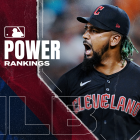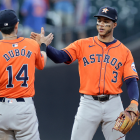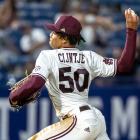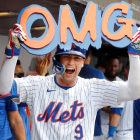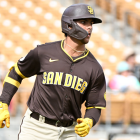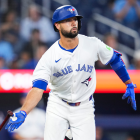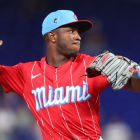For better or worse, we are in the golden age of strikeouts. MLB hitters struck out in 23 percent of all plate appearances in 2019, a new single-season record. In fact, MLB has set a new record high strikeout rate 11 times in the last 12 seasons. Pitchers who rack up strikeouts get paid handsomely (like Gerrit Cole) and hitters who avoid them win MVPs (like Mookie Betts).
Last week we looked at three hitters who, like reigning NL MVP Cody Bellinger, drastically cut their strikeout rates in 2019. This week we're going to shift our attention to the guys on the mound. Here are three pitchers who increased their strikeout rate significantly from 2018 and 2019 and saw their overall performance improve.
It has been an interesting few seasons for Tigers lefty Matthew Boyd. The Blue Jays sent him to Detroit in the David Price trade and it took him a few years to establish himself as a big-league starter. Boyd intentionally scaled back on his fastball velocity in 2018 -- "Adding and subtracting is something I was working on all spring," he told MLB.com's Jason Beck that April -- before going back to cutting it loose in 2019. It makes for an interesting graph:
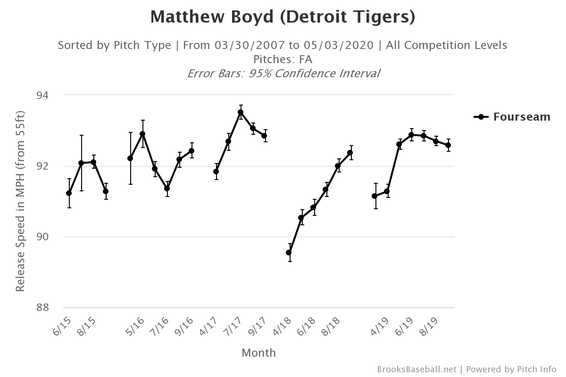
Even with his full velocity, Boyd is not a hard thrower. His heater averaged 92.5 mph last season and topped out at 96.3 mph. Despite that, Boyd posted the ninth-highest strikeout rate (30.2 percent) and the eighth-highest swing and miss rate (14.1 percent) among qualified starters. He raised his strikeout rate 7.8 percentage points last season (22.4 percent to 30.2 percent), tied for the third best year-to-year improvement in the game.
The improved strikeout rate stems from improved secondary pitches as much as improved velocity. The 29-year-old Boyd throws both a slider and a curveball and he throw them a lot, more than 40 percent of the time combined. The slider is his go-to breaking ball but the curveball misses bats as well. Both have better than MLB average swing-and-miss rates, as does his fading changeup.
The Tigers are deep in a rebuild and they have a lot of pitching on the way, so Boyd has been a regular in trade rumors the last 18 months or so. Don't buy into his 2019 success and improved strikeout rate? Consider the teams that had interest in him prior to last year's trade deadline: Astros, Dodgers, Giants, Rays, and Yankees, among others. Basically five of the smartest teams in the game. If those teams buy into a pitcher's improvement, I'm comfortable saying you should too.
Baseball is a game of adjustments, just look at Boyd over the years, and he's still tinkering. He worked to improve his curveball and changeup over the winter and wants to make them a bigger part of his game going forward. His fastball -- it should be noted Boyd's heater has a very high spin rate -- and slider are plenty good enough to miss bats. A better curveball and/or changeup could take him to yet another level in 2020 and beyond.
"At the end of every year, even throughout the year, you're always looking: Where am I deficient? How can I get better," Boyd told Beck in January. "Some of those things you can make adjustments in-season. Sometimes you can use the benefit of five months where you're not pitching competitively. There's little things I was able to do with my changeup and curveball that are a work in progress, that continue to come along, using the stuff we have available to make that better."
White Sox ace Lucas Giolito enjoyed a breakout 2019 season that was the result of many adjustments. He ditched his sinker and emphasized his four-seam fastball, changed his position on the rubber, and also shortened up his arm action. The shorter arm action is a common adjustment these days and contributes to increased velocity. It certainly did in Giolito's case:
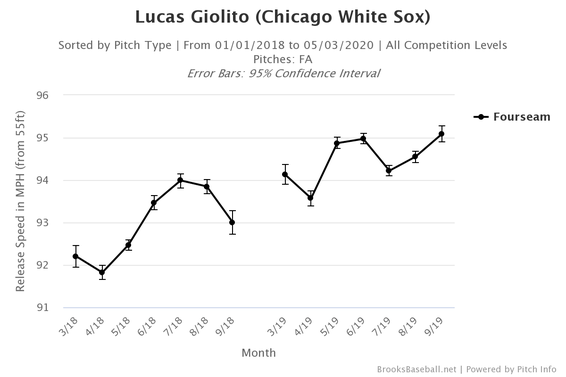
Giolito, who is still only 25, had a historically bad 2018. He led the league in earned runs (118) and walks (90) allowed, and pitched to a 6.13 ERA in 173 1/3 innings. Giolito was the first pitcher to throw enough innings to qualify for the ERA title with an ERA north of 6.00 since Brandon Backe (6.05), Livan Hernandez (6.05), and Nate Robertson (6.35) all did it in 2008.
The myriad of adjustments contributed to Giolito posting a 3.41 ERA in 176 1/3 innings in 2019. He had 103 more strikeouts in 2019 than 2018 despite facing 70 fewer batters. Eighty-three pitchers threw at least 100 innings in both 2018 and 2019, and none improved their strikeout rate as much as Giolito. It's not even close:
- Lucas Giolito: +16.2 percent (16.1 percent in 2018 to 32.3 percent in 2019)
- Mike Clevinger: +8.3 percent (25.6 percent to 33.9 percent)
Giolito nearly doubled the second-best strikeout rate improvement. The gap between No. 1 and No. 2 is the same as the gap between No. 2 and No. 40. The league average strikeout rate was 23.0 percent last season. Giolito went from well below that in 2018 to well above it in 2019. Dramatic doesn't begin to describe the year-to-year improvement.
In addition to the strikeouts, Giolito also cut his walk rate from 11.6 percent in 2018 to 8.1 percent in 2019 (the league average is 8.5 percent). That's the fourth best year-to-year walk rate improvement. As a result, Giolito's K-BB% improvement was the best in baseball at 19.7 percent (4.5 percent to 24.2 percent). Lance Lynn is a distant second at 9.2 percent (12.2 percent to 21.4 percent).
Giolito always had ability. He was a top 2012 draft prospect before elbow concerns caused him to slip into the middle of the first round, and he was consistently ranked among the top prospects in baseball from 2014-17. The tools were always there for a 30 percent strikeout rate. Last year's adjustments helped Giolito get to that level, and those adjustments are tangible reasons to believe this is the real Giolito going forward.
"This year was like the debut of all the stuff that I worked on in the offseason put together. I was still working on stuff in Spring Training. I was still working on stuff in April," Giolito told MLB.com's Scott Merkin last September. "Now the baseline is there. I'm not going into this offseason in October and learning all this new stuff. I'm just going to perfect it. I want to make everything better. I want to get more consistent. I'm excited because I just can't wait to see all the areas I can improve."
The last few seasons have been a whirlwind for Sonny Gray. The 30-year-old finished third in the Cy Young voting in 2015, was injured and ineffective in 2016, traded at midseason in 2017, run out of New York in 2018, and among the game's best pitchers in 2019. The Yankees traded Gray to the Reds last offseason and he responded with the best season of his career.
Even at his best with the Athletics, Gray was never a high strikeout pitcher. He fanned 20.3 percent of the batters he faced during his 2015 All-Star season and his full season career best prior to last season was a 22.6 percent strikeout rate in 2017. That was more or less league average. Last year Gray's strikeout rate jumped to 28.9 percent. The biggest year-to-year strikeout rate improvements:
- Lucas Giolito: +16.2 percent (16.1 percent in 2018 to 32.3 percent in 2019)
- Mike Clevinger: +8.3 percent (25.6 percent to 33.9 percent)
- Matthew Boyd: +7.8 percent (22.4 percent to 30.2 percent)
- Sonny Gray: +7.8 percent (21.1 percent to 28.9 percent)
Gray went into the 2019 season with nearly as many bi- league innings as the other three pitchers on that list combined (900 2/3 to 1,074 2/3), so he is the elder statesman of the group. He famously complained the Yankees had him throwing too many sliders, but his bounce-back last season was thanks to largely to his slider, which he threw more than ever:
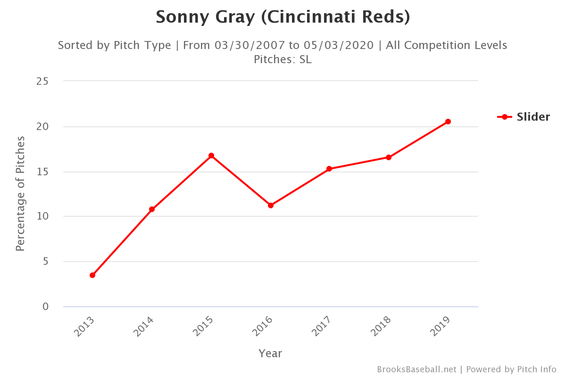
Go figure. Gray's improved strikeout rate was not only the result of throwing more sliders though. It was the overall pitch mix. He threw the slider more in two-strike counts, specifically, and better used his fastball and curveball to set it up. Gray doesn't throw his changeup much but he has four pitches (four-seamer, sinker, curveball, slider), and three have exceptionally high spin rates:
- Four-seamer: 2,527 rpm (19th highest in MLB)
- Curveball: 2,988 rpm (11th)
- Slider: 2,868 rpm (14th)
Three top-20 pitches by spin rate. No other pitcher can make that claim. The Yankees knew that and tried to get Gray to lean on his slider, but perhaps didn't convey it effectively. With the Reds, Gray reunited with pitching coach Derek Johnson -- he was Gray's pitching coach at Vanderbilt -- and Johnson got him to tweak his arsenal, and the results followed.
Even when he was having success early in his career with the Athletics, it always seemed like Gray had the tools to be even better. He could really spin and manipulate the baseball, and the Yankees hoped they could turn the potential into production. It didn't happen. The Reds wisely bought low last offseason and Johnson was able to get through to Gray the way the Yankees were unable, and the result is a greatly improved strikeout rate and one of the National League's best starters.
"I feel like I can throw the ball way better than I have consistently," Gray told John Perrotto of Forbes last August. "I think it's more a mindset. Just go out there and do it. Go out there and be the best. That's all I'm looking to do."
















